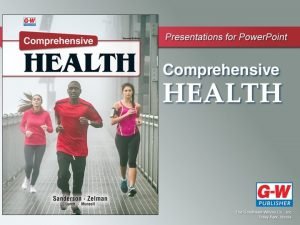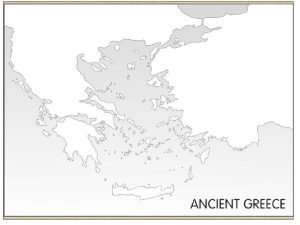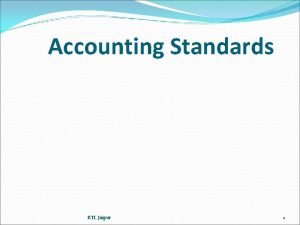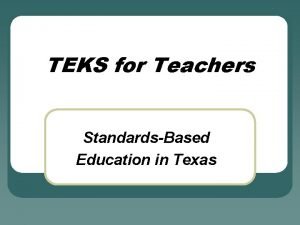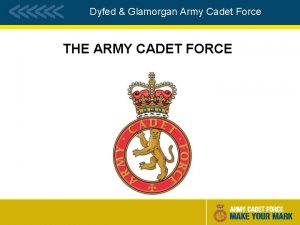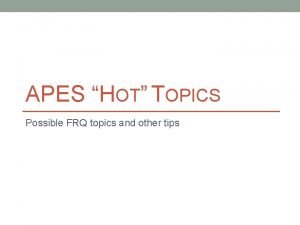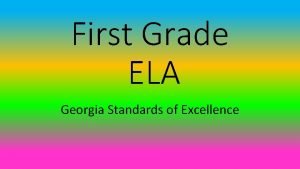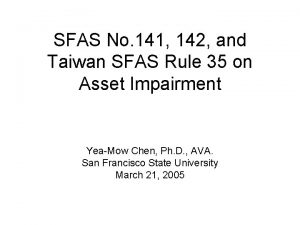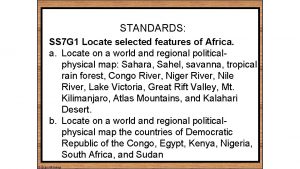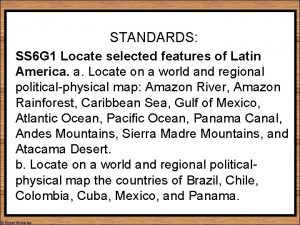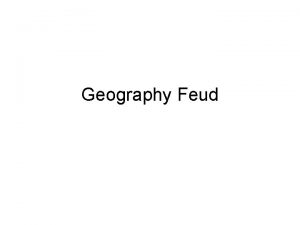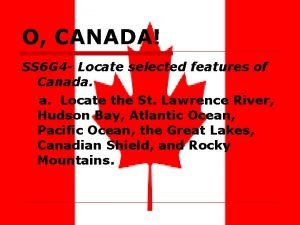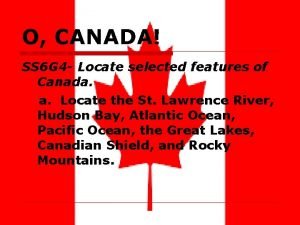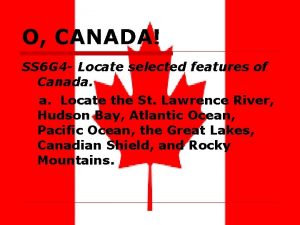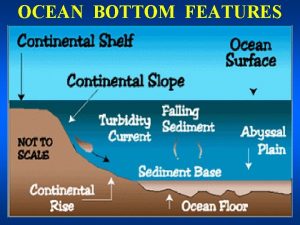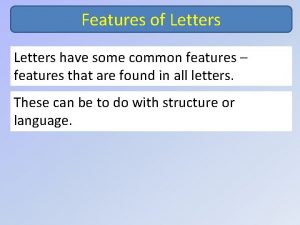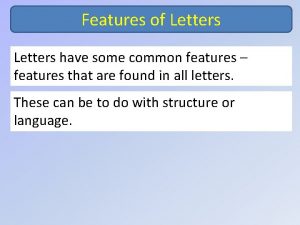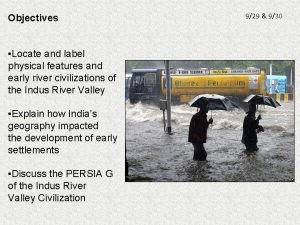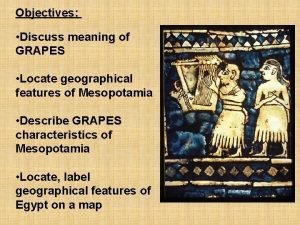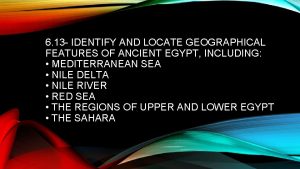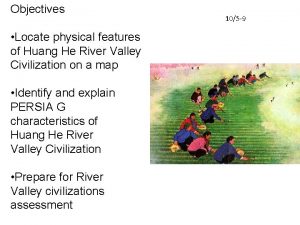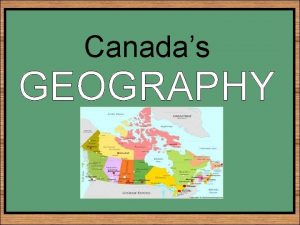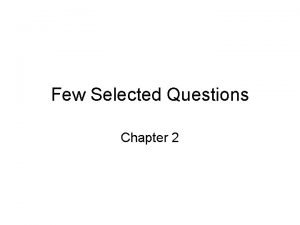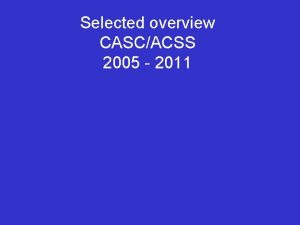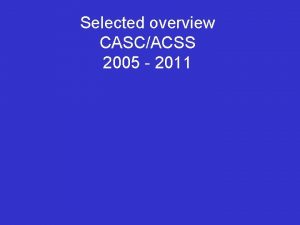STANDARDS SS 6 G 1 Locate selected features



























































- Slides: 59

STANDARDS: SS 6 G 1 Locate selected features of Latin America. a. Locate on a world and regional political-physical map: Amazon River, Amazon Rainforest, Caribbean Sea, Gulf of Mexico, Atlantic Ocean, Pacific Ocean, Panama Canal, Andes Mountains, Sierra Madre Mountains, and Atacama Desert. b. Locate on a world and regional politicalphysical map the countries of Brazil, Chile, Colombia, Cuba, Mexico, and Panama. © Brain Wrinkles

© Brain Wrinkles Politica 1 & Physical Features of Latin America PART ONE: Use a pen to label the following 6 countries on the map. • Brazil • Chile • Colombia • Cuba • Mexico • Panama Next, use a marker to outline the political border of each country. PART TWO: Draw and label the following 10 physical features on the map. *Make a map key to accompany your map. For example, use triangles to represent mountains. • • • Amazon River Amazon Rainforest Caribbean Sea Gulf of Mexico Pacific Ocean Atlantic Ocean Panama Canal Andes Mountains Sierra Madre Mountains Atacama Desert

Politica 1 & Physical Features of Latin America Map Key © Brain Wrinkles

Latin America’s Geography CLOZE Notes 1 Geography • Latin America is located in the ____________. • It is a ____________ that includes most of the countries in the three regions of South America, Central America, and the Caribbean Islands. • Latin America is bordered by the ____________ to the west and the ____________ to the east. Culture • Latin America is not a continent, but rather a ____________. • Latin American countries share a similar ____________. • The cultural element that unites the countries is language (____________ ). • The region is called Latin America because these languages developed from the ____________ language. Regions • Latin America is divided into ____________ : 1. ____________ and Central America 2. The ____________ Islands 3. ____________ MEXICO & CENTRAL AMERICA • ____________(about as wide as the US) • ____________ dominate the region. • They are part of a ____________ that extends from Canada, through the US, and all the way to the tip of South America. • There is a ____________ in Mexico. • It lies between the Sierra Madre mountains and makes up ____________ of the country’s area. • Central America is an ____________. • An isthmus is a ____________ that has water on both sides and joins 2 larger bodies of water. • There are ____________ in Central America, as a result, their soil is arable (fertile) and many people farm lands. © Brain Wrinkles

Latin America’s Geography CLOZE Notes 2 Gulf of Mexico • The Gulf of Mexico is a body of water that lies between ____________. • It is an “arm” of the ____________. • The Gulf of Mexico is bordered by the ____________ , Mexico to the south, and Cuba to the east. • The ____________ and Rio Grande are two major rivers that flow into the Gulf of Mexico. Sierra Madre Mountains • The Sierra Madre Mountains are the main mountain system ____________. • The range contains ____________ : the Sierra Madre Occidental in the west, the Sierra Madre Oriental in the east, and the Sierra Madre del Sur, which extends along the southern coast. • The Sierra Madre range contains some of the highest ____________ in Latin America. Panama Canal • The Panama Canal is a ____________ across the isthmus of Panama in Central America. • It is a ____________ that allows ships to travel between the Pacific and Atlantic oceans. • The Panama Canal is nearly ____________ long. • It handles a large volume of ____________ and enables ships to avoid traveling around South America, reducing their voyages by thousands of miles and many days. • It consists of artificially created lakes, channels, and a series of locks, or water-filled chambers, that ____________ through the mountainous terrain of central Panama. CARIBBEAN ISLANDS • The smaller islands are ____________ (skeletons of tiny sea animals, a rock-like substance). • The larger islands are actually tops of ____________. • Examples: ____________ , Jamaica Caribbean Sea • The Caribbean Sea is ____________ of the Atlantic Ocean. • It is located between Cuba and South America and ____________. • The Caribbean Sea is a ____________ for Latin American countries. • It is also a ____________ that is noted for its mild tropical climate and beautiful beaches. © Brain Wrinkles

Latin America’s Geography CLOZE Notes 3 SOUTH AMERICA Andes Mountains • The Andes Mountains run 4, 500 miles along the ____________ of South America. • The Andes are the ____________________ in the world. • They rise at some points to 20, 000 feet—the same height as ____________ buildings stacked on top of each other! Atacama Desert • The Atacama Desert is ____________ at a high elevation in the Andes Mountains. • The desert’s average temperature is ____________. • Also, it’s one of the ____________ with very little recorded rainfall annually. • Parts of the Atacama Desert have never had ____________. Amazon Rainforest • The Amazon Rainforest spreads across much of ____________ and covers 1/3 rd of the continent. • It is the ____________ in the world. • The Amazon Rainforest is home to over ____________ , 1, 000 different species of birds, and 2. 5 million different kinds of insects. • The Amazon Rainforest’s plants produce ____________ of the world’s oxygen supply. • It is often called the “____________ ”. Amazon River • The Amazon River is the ____________ in the world (the 1 st is the Nile River). • It carries the ____________ of any river in the world. • The Amazon River stretches ____________ (primarily across Brazil) to the Atlantic Ocean. • The Amazon River contains ____________ in the world! • It serves as a ____________ where it’s hard to build roads. • The Amazon also provides food and ____________. Pacific Ocean • The Pacific Ocean is the ____________. • It touches the ____________ of South America. Atlantic Ocean • The Atlantic Ocean is the world’s ____________. • It is ____________ of South America. © Brain Wrinkles

Geography of Latin America

Geography • Latin America is located in the Western Hemisphere. • It is a large land area that includes most of the countries in the three regions of South America, Central America, and the Caribbean Islands. • Latin America is bordered by the Pacific Ocean to the west and the Atlantic Ocean to the east.

© Brain Wrinkles

Culture • Latin America is not a continent, but rather a cultural region. • Latin American countries share a similar culture and history. • The cultural element that unites the countries is language (Spanish and Portuguese). • The region is called Latin America because these languages developed from the Latin language.

Regions Latin America is divided into three regions: 1. Mexico and Central America 2. The Caribbean Islands 3. South America

Mexico & Central America

Mexico & Central America • 2, 500 miles (about as wide as the US) • Mountains dominate the region. • They are part of a huge system that extends from Canada, through the US, and all the way to the tip of South America. • There is a central plateau in Mexico. • It lies between the Sierra Madre mountains and makes up more than half of the country’s area.

© Brain Wrinkles

Mexico & Central America • Central America is an isthmus. • An isthmus is a narrow strip of land that has water on both sides and joins 2 larger bodies of water. • There are many volcanoes in Central America, as a result, their soil is arable (fertile) and many people farm lands

Gulf of Mexico • The Gulf of Mexico is a body of water that lies between Mexico and Florida. • It is an “arm” of the Atlantic Ocean. • The Gulf of Mexico is bordered by the United States to the north, Mexico to the south, and Cuba to the east. • The Mississippi River and Rio Grande are two major rivers that flow into the Gulf of


Sierra Madre Mountains • The Sierra Madre Mountains are the main mountain system in Mexico. • The range contains 3 major chains: the Sierra Madre Occidental in the west, the Sierra Madre Oriental in the east, and the Sierra Madre del Sur, which extends along the southern coast. • The Sierra Madre range contains some of the highest mountains and volcanoes in Latin America.




Panama Canal • The Panama Canal is a man-made feature across the isthmus of Panama in Central America. • It is a major “shortcut” that allows ships to travel between the Pacific and Atlantic oceans. • The Panama Canal is nearly 50 miles long.


Panama Canal • It handles a large volume of world shipping and enables ships to avoid traveling around South America, reducing their voyages by thousands of miles and many days. • It consists of artificially created lakes, channels, and a series of locks, or waterfilled chambers, that raise and lower ships through the mountainous terrain of central Panama.



Caribbean Islands

Caribbean Islands • The smaller islands are made of coral (skeletons of tiny sea animals, a rock-like substance). • The larger islands are actually tops of underwater mountains. • Examples: Cuba, Jamaica


Caribbean Sea • The Caribbean Sea is another arm of the Atlantic ocean. • It is located between Cuba and South America and surrounds the Caribbean islands.


Caribbean Sea • The Caribbean Sea is a major trade route for Latin American countries. • It is also a popular tourist area that is noted for its mild tropical climate and beautiful beaches.


South America


Andes Mountains • The Andes Mountains run 4, 500 miles along the west coast of South America. • The Andes are the longest continuous mountain range in the world. • They rise at some points to 20, 000 feet— the same height as twenty 100 story buildings stacked on top of each other!




Atacama Desert • The Atacama Desert is located in Chile at a high elevation in the Andes Mountains. • The desert’s average temperature is pretty chilly. • Also, it’s one of the driest places on earth with very little recorded rainfall annually. • Parts of the Atacama Desert have never




Amazon Rainforest • The Amazon Rainforest spreads across much of northern South America and covers 1/3 rd of the continent. • It is the largest tropical rainforest in the world. • The Amazon Rainforest is home to over 40, 000 plants, 1, 000 different species of birds, and 2. 5 million different kinds of insects.



Amazon Rainforest • The Amazon Rainforest’s plants produce more than 20% of the world’s oxygen supply. • It is often called the “lungs of the Earth”.

Amazon River • The Amazon River is the 2 nd longest river in the world (the 1 st is the Nile River). • It carries the greatest volume of water of any river in the world. • The Amazon River stretches 4, 000 miles (primarily across Brazil) to the Atlantic Ocean.


Amazon River • The Amazon River contains 20% of all fresh water in the world! • It serves as a natural highway where it’s hard to build roads. • The Amazon also provides food and hydroelectric power.


Pacific Ocean • The Pacific Ocean is the world’s largest ocean. • It touches the western coast of South America.



Atlantic Ocean • The Atlantic Ocean is the world’s second -largest ocean. • It is located east of South America.


Latin America’s Physical Features Directions: Complete the chart below with information that you learn during the presentation. If time allows, color your illustrations. What: Where: What: Caribbean Sea Sierra Madre Mountains Where: Illustration: Gulf of Mexico Illustration: Where: Illustration: Panama Canal Illustration: What: Where: What: Atacama Desert Where: Illustration: Andes Mountains Illustration: © Brain Wrinkles

Latin America’s Physical Features What: Where: What: Atlantic Ocean Amazon River Directions: Complete the chart below with information that you learn during the presentation. If time allows, color your illustrations. Where: Illustration: Amazon Rainforest Illustration: Where: Illustration: Pacific Ocean Illustration: © Brain Wrinkles

Latin American Landforms Directions: Write the physical features below where they are located in Latin America. • Amazon River • Caribbean Sea • Gulf of Mexico • Pacific Ocean • Panama Canal • Andes Mountain • Sierra Madre Mountains • Atacama Desert • Amazon Rainforest • Atlantic Ocean Mexico & Central America © Brain Wrinkles Caribbean South America
 Factors determining service standards
Factors determining service standards Formula of potassium chloride
Formula of potassium chloride Everyone selected to serve on this jury
Everyone selected to serve on this jury Narrative report with contextual description
Narrative report with contextual description Three randomly selected households are surveyed 2 6 7
Three randomly selected households are surveyed 2 6 7 Weights of the backpacks of first graders on a school bus.
Weights of the backpacks of first graders on a school bus. Conditional distribution
Conditional distribution Qualitative and quantitative data analysis
Qualitative and quantitative data analysis Sprite lfs
Sprite lfs Vba listbox selected item value
Vba listbox selected item value K selected
K selected Word basic
Word basic Gwen harwood: selected poems
Gwen harwood: selected poems Survivorship curve for k selected species
Survivorship curve for k selected species Selected response tasks
Selected response tasks K selected species survivorship curve
K selected species survivorship curve R-selected species
R-selected species Fort bragg population pyramid
Fort bragg population pyramid Web authoring using adobe dreamweaver - selected response
Web authoring using adobe dreamweaver - selected response Selected response assessment
Selected response assessment Playstation | congratulations, you've been selected!
Playstation | congratulations, you've been selected! 8255 block diagram
8255 block diagram Example of r selected species
Example of r selected species At the end of the story what makes montresor feel sick
At the end of the story what makes montresor feel sick Word forms
Word forms Suez on world map
Suez on world map These are sites that focus on short updates from the users
These are sites that focus on short updates from the users Where does momaday shift the sentence length and structure
Where does momaday shift the sentence length and structure Constantinople map
Constantinople map Thesis statement
Thesis statement Read carefully synonym
Read carefully synonym Label it
Label it Texas 811 update ticket
Texas 811 update ticket Locate the centroid of the plane area shown.
Locate the centroid of the plane area shown. Apical radial pulse
Apical radial pulse![[bwa_aln] fail to locate the index [bwa_aln] fail to locate the index](data:image/svg+xml,%3Csvg%20xmlns=%22http://www.w3.org/2000/svg%22%20viewBox=%220%200%20200%20200%22%3E%3C/svg%3E) [bwa_aln] fail to locate the index
[bwa_aln] fail to locate the index The ability to locate interpret and apply information
The ability to locate interpret and apply information The ability to locate interpret and apply information
The ability to locate interpret and apply information Ancient greece map with labels
Ancient greece map with labels Locate the and place your spool of thread
Locate the and place your spool of thread List of accounting standards in india
List of accounting standards in india How to write teks standards
How to write teks standards Army cadet force syllabus
Army cadet force syllabus List of aaoifi standards
List of aaoifi standards Ccqi perinatal standards
Ccqi perinatal standards Stem standards of practice
Stem standards of practice Economics standards georgia
Economics standards georgia Sqa art expressive evaluation template
Sqa art expressive evaluation template Apes frq by topic
Apes frq by topic First grade reading standards georgia
First grade reading standards georgia Eyitt course
Eyitt course Sri lanka auditing standards in sinhala
Sri lanka auditing standards in sinhala Sfas no 142
Sfas no 142 Strrea
Strrea Local accounting
Local accounting Sqa higher english understanding standards
Sqa higher english understanding standards Technology standards ohio
Technology standards ohio Asme mission statement
Asme mission statement C coding best practices
C coding best practices Data center standards best practices
Data center standards best practices




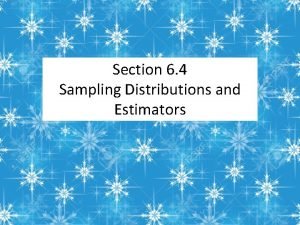






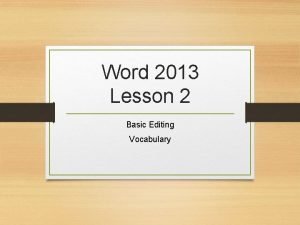


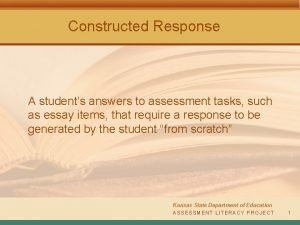
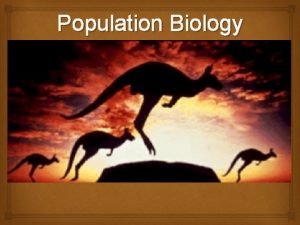
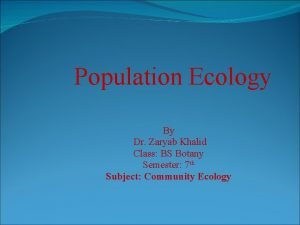





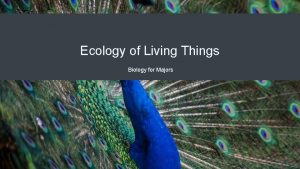
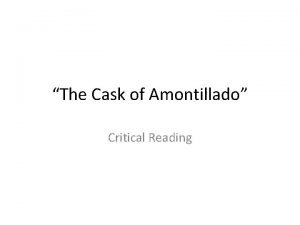

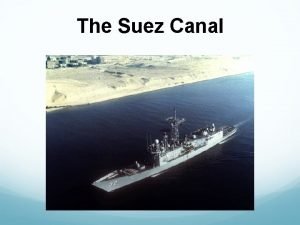

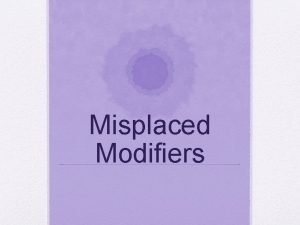
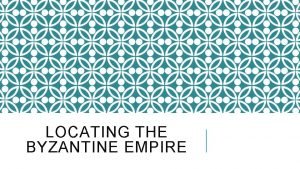

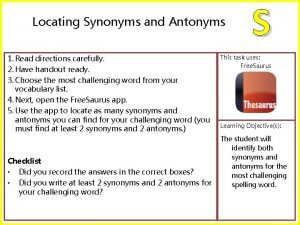


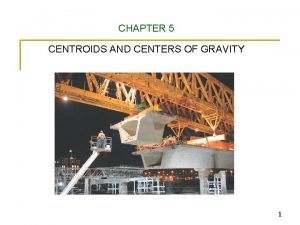
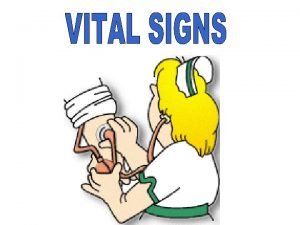
![[bwa_aln] fail to locate the index [bwa_aln] fail to locate the index](https://slidetodoc.com/wp-content/uploads/2020/12/3295376_b0e5b7208bf954ad4902201a58b29fbc-300x225.jpg)
